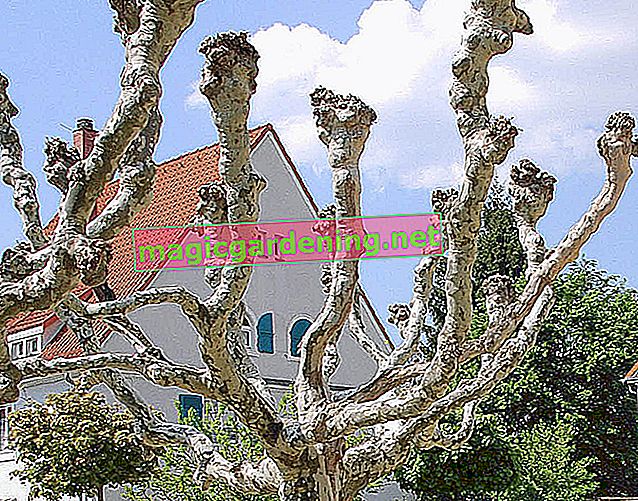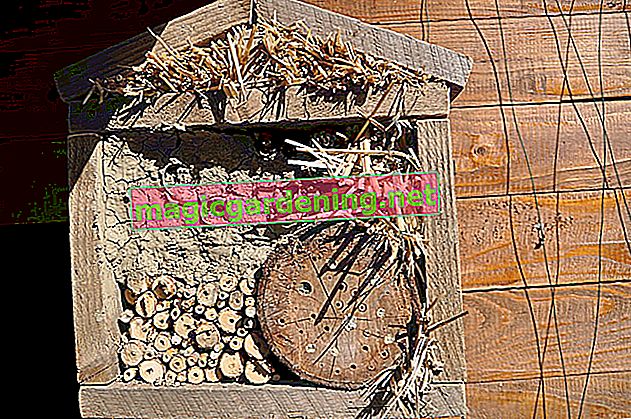
The best cut date is in autumn
The growth of most maple species is characterized by a strong flow of sap, which only subsides for a short time in autumn. If you prune the tree back in the middle of the growing season, the sap will flow freely. In order to prevent bleeding, the choice of date for the tree pruning primarily takes account of this special property of maple trees. These criteria characterize the best time:
- Mild, dry weather in autumn
- No blazing sun, no rain and no frost
also read
- How to cut hawthorn correctly - instructions for the perfect tree cut
- Cutting cinnamon maple - how to do it right
- Planting maple properly - a guide for newbies
In order to prune a maple without a strong flow of sap, the measure should be completed by mid / end of January at the latest. The sap pressure increases in the late winter of species and varieties that sprout early.
Two exceptions to the appointment rule
The time schedule for the tree pruning is of course not firmly cemented for autumn. Robust field maple (Acer campestre) and Asian maple (Acer palmatum) are two exceptions to the rule. To ensure that the field maple retains its neat appearance as a fast-growing hedge, you can cut back shoots that are too long in autumn, early spring and again in June. The picturesque varieties of the maple should ideally be cut in spring, just before the leaves appear.
Preparatory work - this is what you should pay attention to
The sword of Damocles from fungal infections dangles over every cut of the maple tree. Please do not cut the tree or shrub until you have cleaned the cutting tool and disinfected it with alcohol. Before doing this, sharpen the blades with a whetstone so that the cuts do not fray and cause pathogens to develop.
Also protect your skin and clothing from the sticky sap. Even amidst dormancy, the syrupy liquid will flow out of the bark in small amounts when you prune the branches.
The cut leaves old wood untouched - this is how it works
The careful choice of dates in autumn and the recommended preparations are the perfect start for professional tree pruning. If you follow these instructions for the cut, you've done everything right:
- Cut back branches that are too long only in the area of the annual wood
- Make an incision a few millimeters above a leaf lump or sleeping eye
- Cut slightly at an angle so that rainwater and sap can run off
It is characteristic of maple that the tree or shrub does not sprout again or only slowly sprouts from old wood. Therefore, limit the pruning to the area that has grown over the past year. You should cut back dead wood except for astring and leave no stubs. The small bulge (astring) between the branch and the trunk must not be damaged.
Thinning out thick maple branches - how to do it right
If you want to remove a thick branch from the old, large maple tree, the measure requires an alternative cut. This is how it works in 3 steps:
- At a distance of 30-50 cm from the trunk, saw the branch from below to the middle
- Now move the saw outwards by 10 cm and continue sawing from above until the branch breaks off
- In the third step, cut back the remaining branch until just before the astring
Finally, smooth the cut with a sharp, disinfected knife.
When is tree pruning mandatory?
A maple tree develops its shapely crown without a regular pruning. In view of the low cutting tolerance, you should only prune trees and shrubs of this genus when necessary. However, in three cases it is essential that you prune back a maple:
- After planting bare-root goods, prune all shoots by a quarter to a third
- After transplanting, compensate for the lost root mass by pruning proportionally
- Sick shoots cut into healthy wood
Wound closure - yes or no?
Thanks to modern research results, wound closure after a tree cut has come under fire. Intensive field research by tree surgeons has shown that an airtight seal on cuts does more harm than good. The injured tissue does not heal like human skin. Rather, a callus layer overlaps the wound and encapsulates the injured wood. Fresh wood, called cambium, then forms over this partition.
Sealing with tree wax (€ 5.99 on Amazon *) would only disrupt the natural healing process. Larger cut wounds should only be treated after a tree cut in autumn in order to protect the valuable callus tissue from frost. For this purpose, coat the wound edges with tree wax or Lac Balsam.
Tips
Maple pruning doesn't just refer to the branches and crown. Sometimes a root cut comes into focus because there is no gap on the tree disc for beautiful underplanting. There's nothing wrong with pruning offending roots on a well-established maple, as long as you don't remove more than a third of the strands.








